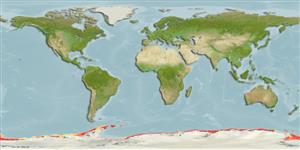Teleostei (teleosts) >
Perciformes/Notothenioidei (Icefishes) >
Channichthyidae (Crocodile icefishes)
Etymology: Chaenodraco: Greek, chaeno = to yawn + Greek, drako = dragon (Ref. 45335).
Eponymy: Dr Edward Adrian Wilson (1872–1912) was an English physician, polar explorer, painter and natural historian. [...] (Ref. 128868), visit book page.
More on author: Regan.
Environment: milieu / climate zone / depth range / distribution range
Ecology
Marine; benthopelagic; depth range 200 - 800 m (Ref. 5200). Polar; 60°S - 78°S, 180°W - 180°E (Ref. 5200)
Southern Ocean: Circum-Antarctic on Antarctic continental shelf. Northernmost records from vicinity of South Orkney Islands and Antarctic Peninsula.
Length at first maturity / Size / Weight / Age
Maturity: Lm ?, range 23 - ? cm
Max length : 43.0 cm TL male/unsexed; (Ref. 5200); common length : 30.0 cm TL male/unsexed; (Ref. 2805)
Dorsal spines (total): 5 - 8; Dorsal soft rays (total): 38 - 42; Anal spines: 0; Anal soft rays: 32 - 36. Supraorbital ridge not crenulated. Middle lateral line restricted to caudal peduncle; lower lateral line originating from in front of anal-fin origin to above sixth anal ray. Maxilla extending to below anterior third of eye. Opercular bones with 2 upper and 3 lower spines. Preopercular-mandibular canal not joined to temporal canal. Pelvic fins extending beyond anal-fin origin. In life, pale grey, whitish ventrally. Differentiated by the dorsoventrally oval shape; the prominent distally rounded rostrum, pseudo-rostrum and pseudo-antirostrum; the clearly defined excisura ostii and pseudo-excisura ostii; the acutely constricted collum; and the well developed colliculli.
Ontogeny: The excisura ostii and the pseudo-excisura ostii become deeper and the crista inferior becomes less distinct with an increase in the fish size.
Common in shallower waters of the continental shelf, especially on banks less than 250 m deep in areas where local upwelling increase food supply (Ref. 6390). Postlarvae and pelagic juveniles are also found in the upper 100 m (Ref. 5200). Food consists of fishes and krill. Spawn in winter (Ref. 6390). Larval pelagic phase is long (Ref. 28915). Prey to penguins and seals (Ref. 6390). Utilized as a food fish (Ref. 5200).
Iwami, T. and K.-H. Kock, 1990. Channichthyidae. p. 381-389. In O. Gon and P.C. Heemstra (eds.) Fishes of the Southern Ocean. J.L.B. Smith Institute of Ichthyology, Grahamstown, South Africa. 462 p. (Ref. 5200)
IUCN Red List Status (Ref. 130435: Version 2024-2)
Threat to humans
Harmless
Human uses
Fisheries: minor commercial
Tools
Special reports
Download XML
Internet sources
Estimates based on models
Preferred temperature (Ref.
123201): -1.8 - 1.4, mean -0.8 °C (based on 825 cells).
Phylogenetic diversity index (Ref.
82804): PD
50 = 1.0000 [Uniqueness, from 0.5 = low to 2.0 = high].
Bayesian length-weight: a=0.00098 (0.00057 - 0.00167), b=3.53 (3.38 - 3.68), in cm total length, based on LWR estimates for this species & (Sub)family-body (Ref.
93245).
Trophic level (Ref.
69278): 3.2 ±0.2 se; based on diet studies.
Resilience (Ref.
120179): Medium, minimum population doubling time 1.4 - 4.4 years (Fec = 393-862).
Fishing Vulnerability (Ref.
59153): Low to moderate vulnerability (33 of 100).
Climate Vulnerability (Ref.
125649): High vulnerability (64 of 100).
Nutrients (Ref.
124155): Calcium = 24.1 [13.1, 52.5] mg/100g; Iron = 0.394 [0.164, 0.807] mg/100g; Protein = 16.6 [14.9, 18.4] %; Omega3 = 0.238 [0.110, 0.509] g/100g; Selenium = 23 [8, 56] μg/100g; VitaminA = 20.2 [4.2, 101.6] μg/100g; Zinc = 0.466 [0.301, 0.712] mg/100g (wet weight);
